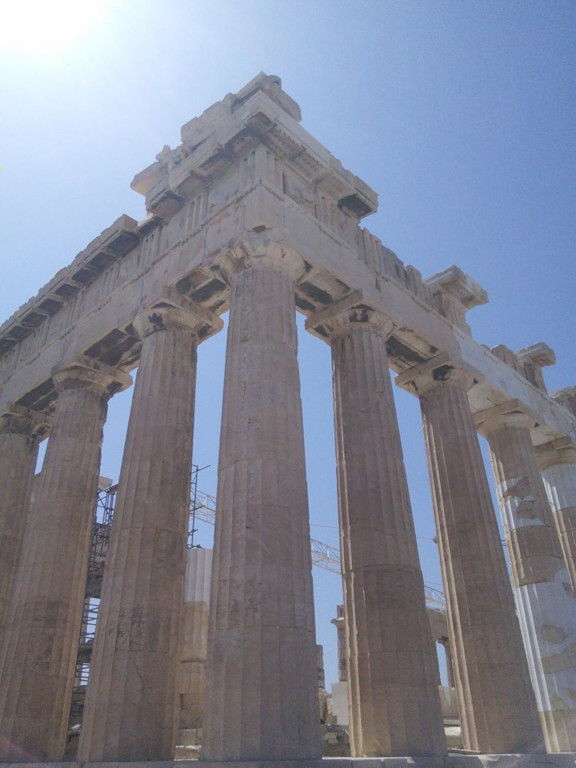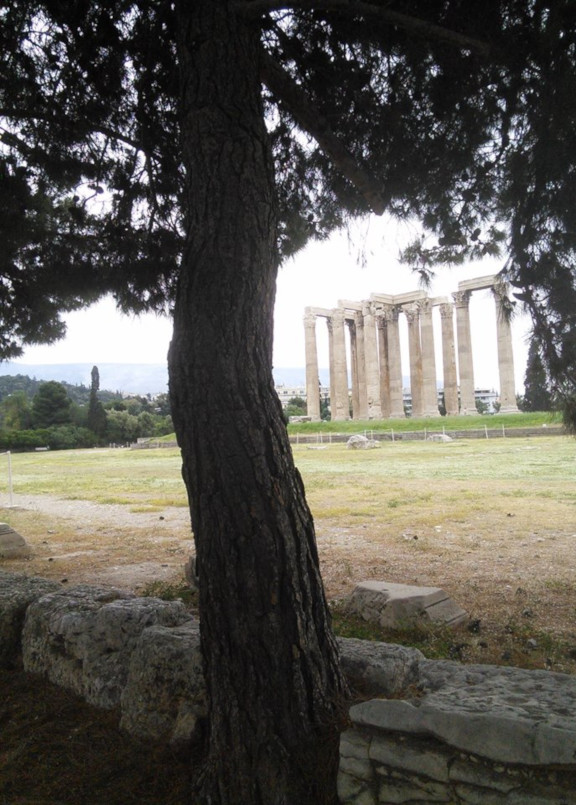Athens, Greece - April 2018
The Airline and the Airport
Heathrow Terminal Five is all fully accessible, with lifts, escalators and disabled toilets throughout the terminal. I was offered special assistance at the check-in, which I declined politely, security is aware and helpful.
We boarded the British Airways flight via a walkway. The flight attendant was very helpful; she took my case and I was led to my seat with my Communicator Guide following behind me.
There was a TV showing all the safety procedures with English subtitles, but for me it was difficult to view. The Flight Attendant offered special assistance for when we landed, which I did not require. Flight time to Athens was 3.5 hours.
At Athens International Airport we disembarked the plane via a walkway. The airport has good facilities for disabled travellers, with lifts, ramps and disabled toilets. At passport control there was a designated section for disabled people, which made getting through very quick.
After proceeding through Arrivals, we then had to go out of the Airport across the road and took the lift down to the Metro. This was well signposted and easy to access, with a moving walkway to use if needed. When we arrived at the ticket booth, we asked for one disabled plus one carer, we then took another lift down to our platform to catch the train. When the train arrived, the gap between the platform and the train was minimal. The trains from the airport to the city centre run every twenty minutes with the journey being around forty to fifty minutes.
When we arrived at Syntagma Metro Station in the city centre, there was a lift in place to take you to the first floor, then another lift to take you to the street level; the platforms were wide with easy access.
The walk from the station to our hotel was around 10 minutes (150 metres), however, walking over cobbles with my suitcase proved a bit problematic.
At the Hotel
We checked into the Cypria Hotel with no issues. There was disabled access via a ramp to the Reception with a disabled toilet. This hotel has a four rating and is in a very good central location.
We were provided with inter-connecting rooms which were quite basic, clean and comfy. However, the bed area was slightly too compact and this made things difficult when moving around. The rooms had a mini bar, plus a kettle and two cups but no tea, milk or coffee on offer. The room was equipped with air conditioning, which in my opinion was not as cold as it should have been. This would not be adequate for the hot summer months.
I did not request a disabled bathroom; it was clean with fresh towels and toiletries. The shower and bath tub were in one with no grab rails in place; however, the floor of the bath tub was not slippery and it had a shower curtain.
The hotel has a large dining area; breakfast in the morning was from 7am to 10.30am. There was plenty to choose from with a cooked breakfast, a selection of cereals, fruit, juices, tea and coffee etc. The access to the breakfast area would be an issue for wheelchair users because the two lifts going up to the dining area appeared not to be wide enough for a wheelchair.
Hotel Cypria has a rooftop bar which boasts astonishing views of the Acropolis. This bar is located by a different lift which takes guests up to the seventh floor. Access to this lift could fit a wheelchair user without a support worker, with the weight restriction being 225kg.

Getting Around
Although Athens is a large city, we found the transportation links quite easy; however, getting around on foot is also doable. The best form of transportation for disabled people is the Metro, as it is frequent and easily accessible, thanks to the 2004 Paralympics.
The main issue getting around on foot was walking on the cobbled streets, as well as the marble walk ways which can be quite slippery. The City has plenty of buses, trams and taxis available.
Attractions
The Acropolis
This attraction is on a huge flat hill, 490 feet above sea level and dates back to the fifth century BC. The ancient ruins consist of The Temple of Erechtheion and at the centre of the Acropolis is the Parthenon.

At the Acropolis ticket area, myself and my communicator guide were granted free admission with no negotiating required. We were then escorted by a very nice member of staff, showing us the wheelchair accessible route with a stair lift and another lift to take us to the top of the hill. At the top there are ancient Greek ruins, I felt very philosophical, “The only true wisdom is in knowing you know nothing.” – Socrates. It was very warm at 25 degrees with no toilets or café.
We were at this attraction for just over an hour, the member of staff who helped us down was not as helpful and we encountered a problem. He would not allow us to use the stair lift for no apparent reason and my communicator guide went to complain at reception whilst I waited by the stair lift. After a short while, the member of staff came back down and allowed me to use the stair lift. I’m not a wheelchair user, but I am entitled to come down the exact way I went up, and I wasn’t going to let an ignorant staff member bully me.

National Historical Museum
After a short coffee break, we went onto the National Historical Museum which was only a short walk from the Acropolis. There was a café and a gift shop onsite, which we did not use.
When we arrived we entered via a flat entrance and were granted free admission after queuing for a short while. I was offered a wheelchair which I politely declined. There were disabled toilets, ramps and lifts available, some artefacts were a little too high to view for a wheelchair user. This museum is very large and will take some time to explore; an hour was enough for me.
The Temple of Olympian Zeus
The Temple dates back to the 6th century B.C. and is very near to the centre of Athens. This attraction was within walking distance from the hotel (15 minutes).

This was an outdoor attraction and when we arrived we both were granted free admission. There was mostly thin grass area and was easy to walk around, some parts being uneven but mainly flat. There were benches around the parameter for visitors to rest and admire the Temple.
The Panathenaic Stadium of Athens
The Panathenaic Stadium is a multi-purpose stadium in the centre of Athens. This stadium hosted the first modern Olympics of 1896.
We both were granted free admission; however, you will need to pay for the Audio Guides. Access to this attraction is mainly flat, but there is a big step up onto the track. Once on the track I decided to go for a jog: unaided, with my support worker videoing the sporting spectacle in action. The Museum is located through a tunnel with stairs going up to get to it, and therefore it is inaccessible for a wheelchair user.
The Tactual Museum
We were hoping to visit this attraction on the first day, but when we arrived it was closed for the Easter holidays. So my communicator guide called and arranged for an appointment on the last day of the trip.
This is a museum for the visually impaired / blind where you can touch the actual copies of artefacts. Access to this museum is by a ramp and we were greeted by a member of staff. The lady took us on a tour and showed me how to touch the exhibits. I could understand her a little but I had my comm guide on standby who signed in SSE (Signed Spoken English).
My experience in this museum was one of the best and I felt the hands-on approach made me appreciate the value of the statues. I would highly recommend a visit more for visually impaired people.
Eating Out
Athens has an array of restaurants catering for mostly Mediterranean dishes, with Kebabs being a favourite of mine. Most establishments are reasonably priced, with a good selection of Greek and Turkish cuisine. Access to most restaurants would prove difficult for wheelchair users; however, there is plenty of seating outside. The main issue here is that a wheelchair user would find it difficult to access the main restaurant and the toilets.

Overall
Cobbled streets, marbled walkways, and ancient ruins, Athens is one of the oldest cities in Europe. Understandably, it is not easy to change history and we would prefer not to, this ancient city was still accessible for the most part. I feel that restaurants and cafes could make more of an effort to put better access where possible for wheelchair users.
During my visit, I noticed parking was very poor, some cars were parked blocking crossings and others were not parked correctly. The UK restrictions do not apply over in Athens; therefore using a vehicle may prove difficult unless you have a Blue Badge which can enable you to park anywhere and anytime.
To sum up, it was an interesting and educational experience and is a place I would happily return to.
